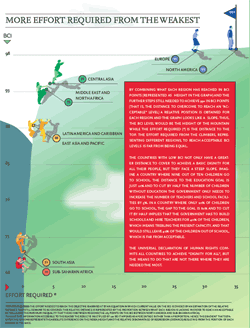More effort required from the weakest
|
By combining what each region has reached in BCI points (represented as height in the graph) and the further steps still needed to achieve 99+ in BCI points (that is, the distance to overcome to reach an “acceptable” level) a relative position is obtained for each region and the graph looks like a slope. Thus, the BCI level would be the height of the mountain while the effort required is the distance to the top. The effort required* from the climbers, representing different regions, to reach acceptable BCI levels is far from being equal. The countries with low BCI not only have a greater distance to cover to achieve a basic dignity for all their people, but they face a steep slope. Imagine a country where nine out of ten children go to school. The distance to the education goal is just 10% and to cut by half the number of children without education the government only needs to increase the number of teachers and school facilities by 5%. In a country where only 20% of children go to school, the gap to the goal is 80% and to cut it by half implies that the government has to build schools and hire teachers for 40% of the children, which means trebling the present capacity. And that would still leave 40% of the children out of school, which is far from acceptable. The Universal Declaration of Human Rights commits all countries to achieve “dignity for all”, but the means to do that are not there where they are needed the most. |
|
|
EFFORT REQUIRED* The effort required to achieve the goal is the result of an equation that divides the current BCI value by an estimate of the relative distance that lies ahead. This relative distance is represented by the ratio between what is missing from each region to achieve an acceptable BCI value (BCI = 99.5) and the maximum verified inequality between regions (28.7 points of BCI that mediate between North America and Sub-Saharan Africa).
|
|
| > Basic Capabilities Index: a starting point | > All Quiet on the Poverty Front | > Evolution by countries and regions |



